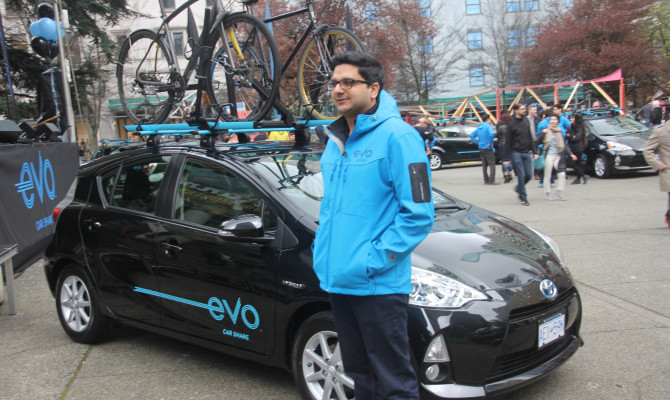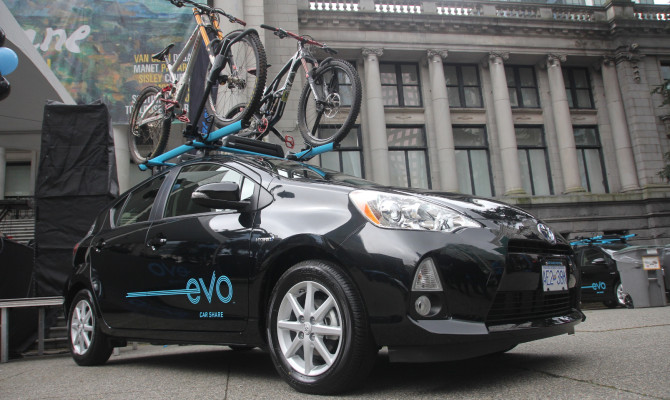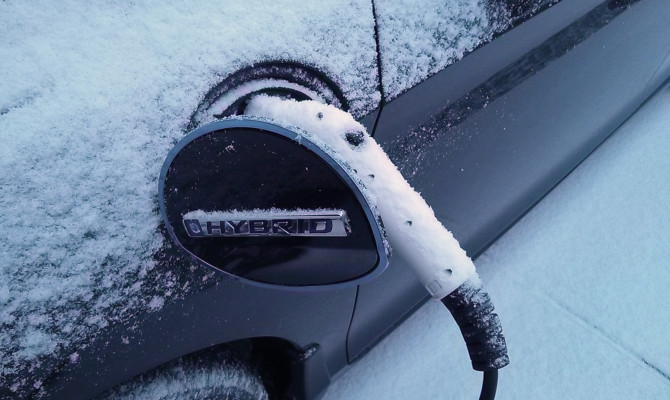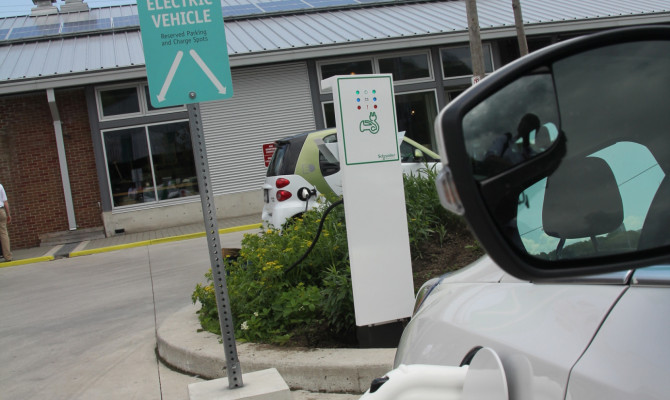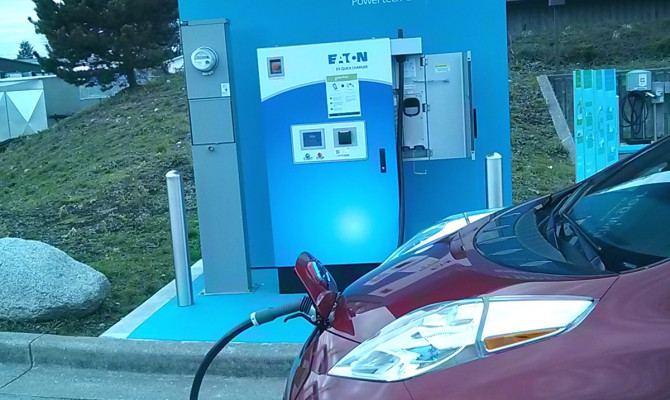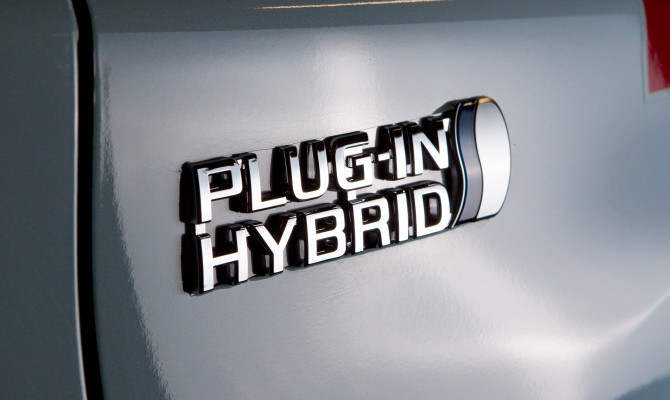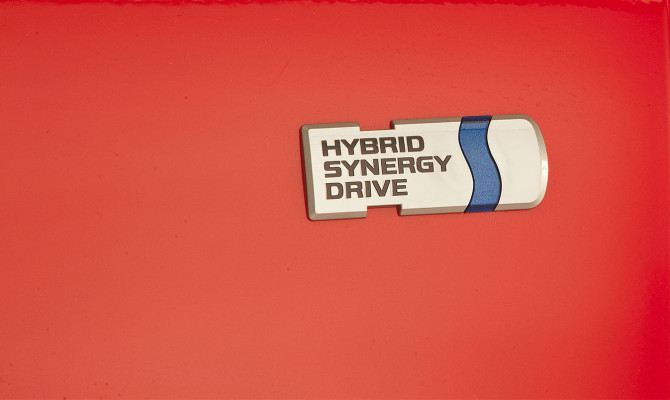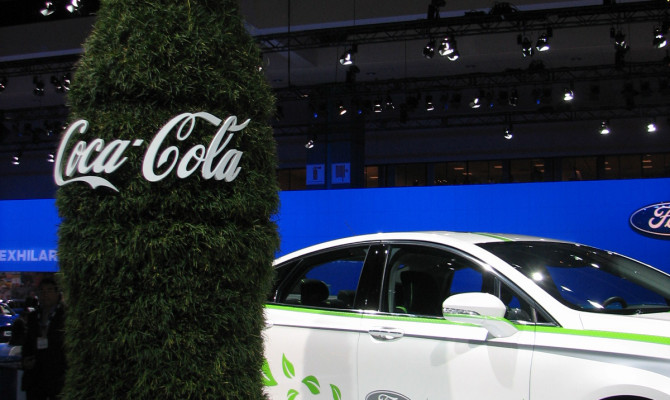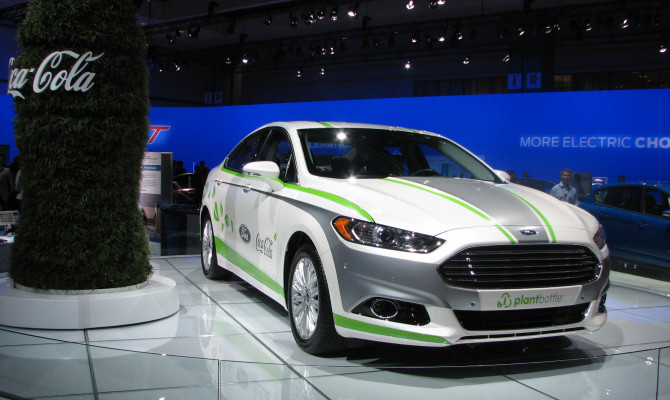The BC Automobile Association (BCAA) recently launched a new car share service with an interesting up-tempo public promotional bash outside the Art Gallery in downtown Vancouver. A 250-strong fleet of Toyota Prius C hybrid vehicles will be available to users of this new service, called Evo, and some of them were on display.
“What we are creating here is the evolution of BCAA – the auto club where you don’t even need to own a car,” said Shan Parmar, Director of Evo Car Share.
BCAA believes car sharing is of growing importance for modern city dwellers and is a sustainable mobility option. It’s also a way to improve the on-going issue of traffic congestion. A single car share vehicle can remove up to 12 private vehicles off the road, according to a recent Metro Vancouver study report.
Over the past 20 years, the car sharing service business has grown rapidly and it’s now available in over 600 cities around the world. Major auto makers, like Mercedes-Benz and BMW, are also involved in providing this type of service. In Vancouver, Evo joins Zip, Modo and Car2go for a share of the car share pie.
“We believe Vancouverites are looking for a more flexible car share option that allows them to get outdoors and enjoy everything that BC has to offer,” explained Parmar. “Evo is the only one-way car share service that has vehicles with four doors, room for five passengers, bike racks, ski racks and space for cargo. It’s the only car share service designed to fit a BC lifestyle.”
BCAA is the first auto club to provide a car share service, according to Parmar. Initially the Evo service territory, where vehicles can be picked up and must be returned, is a 50 sq km area within Vancouver city. An Evo vehicle can be driven anywhere and then returned anywhere within the Evo service territory.
“We have designated (free) Evo parking spaces throughout the city,” added Parmar. “In addition to that we have permits from the city of Vancouver that allow an Evo vehicle to park in any permit-only or resident-only zones, within the city.”
Parking fees, gasoline, auto insurance and vehicle maintenance are all included with an Evo vehicle. A user of the service only pays for the time that they are logged into the vehicle and it starts on a per-minute fee base of 41 cents. The hourly usage fee rate is $14.99 and it’s $89.99 per day. BCAA members do receive some perks by enrolling in Evo. The ($35.00) registration fee is waived and they also receive a ten per cent usage credit.
The highly fuel-efficient Toyota Prius C is a four-door hatchback that offers seating for five passengers and the Evo vehicles all come equipped with bike/ski racks. An Evo client can locate available Evo vehicles with a downloadable mobile smartphone app or by using the Evo web site.
An Evo client can also unlock the vehicle with the Evo app, or their Evo membership card, when they arrive at the Evo (Prius C) vehicle. The Prius C has a keyless ignition system and the key fob is in the vehicle. If they want to park the vehicle, but not end a session, they lock the vehicle with the key fob and keep it with them. The Evo user meter will, however, continue to run until you return the key fob to the vehicle and log off the session.
“We’re seeing usage from a wide variety of users,” said Parmar. “Young people who don’t own a car. Couples or people with young families, who may own a car, yet sometimes need a second car. People who use the service simply for the convenience, they don’t want the hassle of finding or paying for downtown parking.”
To learn more about how BCAA’s Evo car share service works, visit evo.ca.
“The EcoRun is an event that shows off a variety of eco-friendly vehicles, which include pure electrics, plug-in and conventional hybrids, hydrogen fuel cells, diesel-fuelled powertrains and highly efficient gasoline options.”
The rain is relentless and it’s cold.
But the miserable liquid sunshine couldn’t dampen the spirits of the group of nationwide journalists, who gathered at the Jack Pool Plaza at the Vancouver Convention Centre to kick off the 2015 Automobile Journalists Association of Canada’s (AJAC) annual EcoRun.
The EcoRun is an event that shows off a variety of eco-friendly vehicles, which include pure electrics, plug-in and conventional hybrids, hydrogen fuel cells, diesel-fuelled powertrains and highly efficient gasoline options. Its purpose is to help inform consumers of these alternative options, as well as providing accurate road testing fuel economy numbers.
There’s no size limit on the vehicle either. Heck, we had a Ford F-150 in the pack, along with the midsize Chevrolet Colorado. The objective was to test a variety of vehicles – regardless of shape or size – and show that you don’t have to buy an all-electric vehicle to be eco conscious.
But speaking of all-electric vehicles, the Nissan LEAF was the first of six vehicles I’d drive over the two-day test drive. This year, we ventured onto Vancouver Island through Horseshoe Bay, Nanaimo, Duncan, and Victoria and back through Tsawwassen.
With a full charge on the LEAF’s battery, I wasn’t having any range anxiety.
The trip to the ferry, and then to our first stop totalled a little more than 70 kilometres.
I started with 143 km on my “tank” and ended up with 63km.
As for real world figures, I used up about 80 km of range for a 70.1km trip. I did have the heated steering wheel and seat on, and had the heating on as well because, as I mentioned, it wasn’t warm! And there were a few hills on the way; all of which would deplete the battery more quickly.
Our first stop on the Island was at the Cowichan Regional Visitors Centre in Duncan. If you’re looking for things to do in the area, this is the place where you’ll get lots of great ideas. For example, those who love cheese will find that The Creamery at Cheese Pointe Farm has some incredibly delicious offerings. Or those who want some candied salmon look no further than Mad Dog Crabs. And as a tea lover, TeaFarm, which is Canada’s only tea farm and offers multiple blends of flavourful creations. I could have stayed all day but duty called.
From there, our journey took us to Western Speedway in Victoria for a dynamic handling course.
That part of EcoRun was compliments of the Chevrolet Colorado. The front-wheel drive truck with a six-speed manual transmission did the job and did it well. From the speedway, our drive took us into downtown Victoria and the VW Golf TDI was my fiery chariot.
The next day’s activities would also keep us busy, with a press conference at the BC Legislature, then to Swartz Bay, through Steveston, BC for a fascinating tour of its history, and then finally back home.
I’d have the opportunity to test the Ford Focus with the 1.0L engine, the Jeep Grand Cherokee with the EcoDiesel, and to finish up the day in style, I’d have the Acura RLX Sport Hybrid.
While the AJAC EcoRun wasn’t about crowning winners and losers – although, we were all vying for the coveted Green Jersey award at the end for most efficient driver – the real winners are the consumers.
Not everyone is able to find a place in their home for an electric or hydrogen fuel cell vehicle, but there are gasoline and diesel-powered options that can easily fit into your lifestyle, no matter what kind of driving you do.
For a full list of participating vehicles, and to see photos and data, visit www.ajac.ca and click on the EcoRun tab.
If you would like to plug in an all-electric Nissan LEAF at your home, this weekend is the last chance you will have to get one for nothing!
British Columbia’s SCRAP-IT Program kindly supplied us with one of the eco-friendly sedans as a prize in our Plug-In to Win Contest, which closes at midnight on Sunday (see the link or below for entry details). The winner will be announced online next week and Driveway will feature an interview with the lucky winner in an upcoming edition.
SCRAP-IT announced its new incentive program here last week, which offers a $3,000 rebate for electric car purchasers if they scrap a 2000 or older vehicle. This is in addition to the newly announced provincial government program detailed in our main story today.
The LEAF will be on display at the SCRAP-IT booth throughout this weekend at the Vancouver International Auto Show, in the Vancouver Convention Centre West. Qualifying electric vehicles for the organization’s incentive are listed on the SCRAP-IT.ca website. Take a look because some of them, plus vehicles qualifying under the additional government program, will be at the show to view and some made available there for test drives outside.
For information on electric vehicles and charging systems and infrastructure visit Plug-In BC at: http://pluginbc.ca/
For details of the Clean Energy Vehicle incentive program visit: www.cevforbc.ca
“The incentives are expected to reduce greenhouse gas emissions by the equivalent of taking 1,400 cars off the road…”
(more…)
The reason to have these incentives is to help prime the pump, allow people to look at a new option and help the environment.” – Blair Qualey, President, New Car Dealers Association of BC.
While awareness about clean energy vehicles is growing, incentives to buy are still needed, according to the industry.
“It’s a marathon not a sprint,” said Blair Qualey, President and CEO of the New Car Dealers Association of BC. “We’ve made some good progress in creating awareness of clean energy vehicles and we’re trying to work with government to keep the (CEV incentive) program going. Last year around the same time we were in the same situation, not knowing what’s going to happen.”
The BC Government originally committed $14.3 million to the Clean Energy Vehicle (CEV) Program, back in 2011, to support a market transformation to the use of clean energy in the light duty transportation sector. It tied in with its goal to reduce B.C. greenhouse gas emissions by 33 per cent by 2020, and by 80 per cent by 2050 (compared to 2007 emissions). About 36 per cent of B.C.’s greenhouse gas emissions are estimated to come from the transportation sector.
As long as current funds last and until the program concludes at the end of March, a point-of-sale rebate (up to $5,000) is still available with the purchase of an electric vehicle (EV) and there are rebates (up to $500) available for residential “home” charge stations. Funding for public charge stations concluded at the end of March last year. In addition to plug-in electric vehicles, hydrogen fuel cell vehicles and natural gas vehicles are also included in this incentive program.
B.C. has certainly embraced the switch to clean energy and probably leads the country in adapting to the EV Level 2 (240 volt) public charge stations in place are now in the hundreds, home charge stations are starting to cost less to buy and install as the market expands and more (high-voltage) fast-charge stations will be joining the three already in operation.
That said, the EV is still a fragile market sector that’s struggling to establish a foothold.
When the CEV program started, according to Qualey, the inventory of EVs available for sale at local auto dealerships was very limited. A few years later the supply situation is much better, competition has certainly increased and prices are even starting to drop with increased production volume.
Yet, there’s still a significant price gap between an EV and a comparable gas engine vehicle.
The large spike in the number of buyers who claimed the EV incentive in this past year is a reflection of those changes in the market. The Chevrolet Volt, followed by the Nissan Leaf were (by far) the two most popular vehicle recipients. Interestingly, third most popular EV was the Tesla Model S, since Tesla doesn’t currently even have a walk-in-the-door dealership in B.C.
Most working people commute within the driving range (100 km to 150 km) of a fully charged EV, which makes them viable and the cleanest commuter vehicle choice. A plug-in hybrid electric vehicle (PHEV) can also currently qualify for a $2,500 instant rebate and are another excellent clean vehicle choice. A PHEV typically has an electric-only driving range of about 20 km to 30 km and then switches to hybrid extended range operation.
Quebec recently renewed its clean-vehicle incentive program, which offers up to $8,500 off the price of an EV, for another three years. Ontario also continues to provide a similar program with an up to $8,000 incentive. Some auto manufacturers may have second thoughts about the B.C. market, if incentives are no longer available, as the support costs involved in offering an EV in a product line are high.
“We’re at the point now where we have all the components necessary to do what everybody had envisioned back in 2010,” added Blair Qualey. “The reason to have these incentives is to help prime the pump, allow people to look at a new option and help the environment. All the pieces of the puzzle are there and it would be a shame not to put it together, when we have a chance to succeed.”
Here are some useful Electric Vehicle information web sites:
Hybrid vehicles have never been more affordable and certainly well worth consideration, if you’re thinking about buying a new vehicle…
Tesla CEO Elon Musk recently equated hybrid vehicles to early amphibians that hopped out of the oceans, learned to survive on land and eventually disappeared.
Ironically, if the electric vehicle (EV) evolved in a similar way, Tesla (an exclusively EV company) wouldn’t exist right now and this would probably be in a vibrant Hybrid Age!
Despite the early birth of production EV, hybrid (HEV) and now plug-in hybrid electric vehicle (PHEV) sales continue to rise, new models continue to arrive and at least three all-new PHEVs are expected later this year.
A HEV functions just like, or similar to, a conventional gas-engine vehicle from a driver/owner perspective. It consumes substantially less fuel, especially in an urban environment, and a regenerative braking system can greatly extend the life of brake friction pads.
A PHEV increases the energy saving, money saving, and greenhouse gas reducing advantages by tapping into an electrical source and pulling relatively inexpensive electrical power off the main grid. It then uses this energy to go further on electrical power alone. How far depends primarily on the capacity (size) of its storage battery, but also on the drive system, the terrain and weather conditions and how the PHEV is driven.
Lugging around a bigger battery obviously increases the weight of a PHEV and it takes up either passenger cabin or more likely trunk cargo space. The latest lithium-ion battery packs are lighter and more compact, but the space sacrifice is something that a prospective owner must be willing to live with.
Hybrid owner feedback is generally very positive and the fuel savings can be substantial. That said, you generally pay a premium for this technology, but that gap is rapidly narrowing. Last year, GM slashed $5,000 off the price of its popular Chevrolet Volt, the best selling PHEV on the market. While GM marketing promotes the Volt as an “extended range” electric vehicle, as its road wheels are always driven by an electric motor, it’s still classified as a PHEV. A small on-board gas engine generates electricity, when necessary.
The new Honda Accord Hybrid (a HEV) further blurs the differences between HEV and PHEV, as it uses the same two-motor powertrain used in the Accord Plug-in Hybrid (a PHEV edition that’s currently only sold in selected markets). At speeds under 80 km/h the road wheels are driven by an electric motor and its Atkinson cycle gas engine is only used to generate electrical power, when needed.
The current list price for an Accord EX-L is $29,455 and the Accord Hybrid starts at $29,590, which is only $135 more. The top-line Accord Touring V6 sells for $35,400 and the Touring edition of Accord Hybrid is $36,690, just an extra $290. The price differential is almost non-existent.
Choosing HEV or PHEV boils-down to whether an owner can take full advantage of the plug-in electrical storage feature and normal driving commutes are within the electric-only speed and distance range of the PHEV. A low-speed urban driving commute allowing the PHEV to be charged at home overnight and topped-up again while at work, during the day, would be an ideal scenario.
While the popularity of hybrid vehicles continues to grow, barring a sudden spike in the price of oil/gasoline, a meteoric rise in the popularity of alternatives to the old reliable gas engine vehicle is unlikely. Then again, who knows what the future, or the next twist in evolution, will bring. Hybrid vehicles have never been more affordable and certainly well worth consideration, if you’re thinking about buying a new vehicle.
‘Range anxiety’ is a major mental obstacle for those with the resources to contemplate the purchase of an all-electric car…
The future of cars may be electric… but don’t expect 2014 to be the dawn of the new age.
In fact, I predict there’s a long road ahead for manufacturers trying to woo the driving public into buying a car with a chord attached.
Throw in the sales numbers for all-electric cars, plug-in hybrids and gas-battery hybrids and they don’t come anywhere near five percent of total vehicle sales. The commercial conundrum is that these (more) eco-friendly vehicles come with a premium sticker price beyond most folks and the only way to bring them in range is to sell many more!
Most provincial governments have incentive rebates for those that make a green choice. While successful to a degree, they alone are going to turn us all on.
If gas prices soar then some more buyers will go the hybrid route but that said there are an awful lot of four-cylinder vehicles out there that are remarkably economical on gas. Let’s get our heads out of the dark clouds and accept that economy of purchase and operation are what drives most sales.
I am not an electric car naysayer, far from it, but we have to recognize that much needs to happen before the majority buy into this future. Sticker price is one thing but the single biggest challenge has to be the slow pace of infrastructure to fast-charge cars, whose batteries have run down mid-journey.
‘Range anxiety’ is a major mental obstacle for those with the resources to contemplate the purchase of an all-electric car such as the Nissan Leaf or Mitsubishi iMIEV. For that reason, it seems likely that the likes of the Chevrolet VOLT will enjoy more sales success as a main means of transport because an onboard gas-powered generator is ready to kick in to recharge the battery when the juice runs out. Similarly, the new BMWi3 while available as a pure electric vehicle can also be purchased with a range extending engine.
Other manufacturers are set to follow that same route but in the meantime, the plug-in hybrid, which combines the pulling power of a gas engine and electric motor is the early winner of people’s green-tinged hearts.
But back to the thorny issue of infrastructure. Many advocates want government to play a lead role but with all the demands made on the public pure that’s a dead end street. Maybe the tax incentives they can offer will encourage the private sector.
For instance, the Canadian company Sun Country Highway has announced plans for a charging station network along the length of the Trans-Canada Highway. Other companies operating alongside major highways are extracting planning concessions from local government by installing recharging points.
Hats off to BMW and its holistic approach. The German giant is collaborating with small tech companies, who will work with customers to make sure their homes don’t require a major power refit just to own one of the new i3s.
And, as Dr. Ian Robertson, a BMW management board member, told me at the LA Auto Show recently there are many other power opportunities right in front our eyes. Urban areas are awash with street lights, which could be used as a source for curbside recharging.
He also pointed out that there are many discontinued public phone sites in today’s cities. They have power wired to them and are ready to be tapped, should the phone company want to make a profit of more than a quarter per call.
All of these sensor-based technologies make driving safer today and they could also be considered as building blocks for a more comprehensive automated driving system…
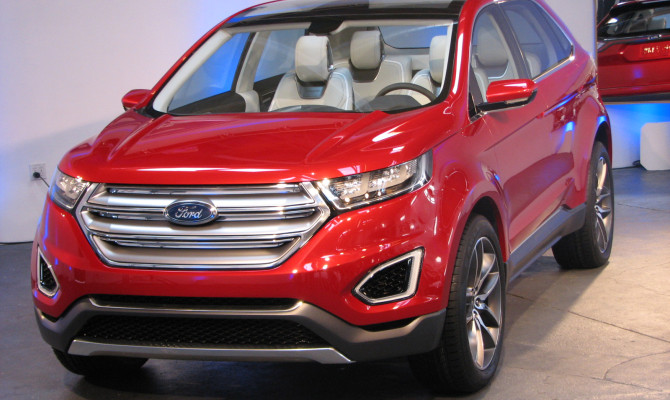
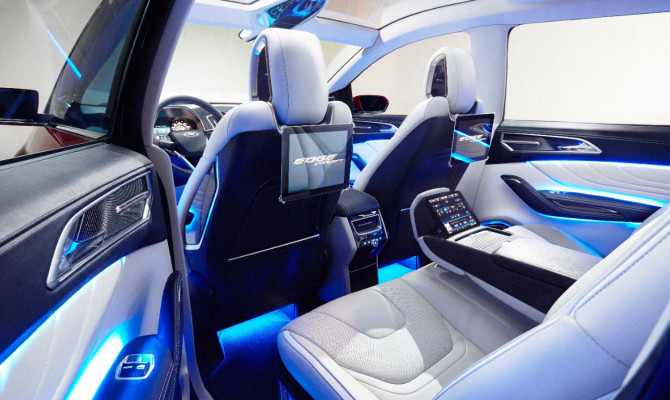
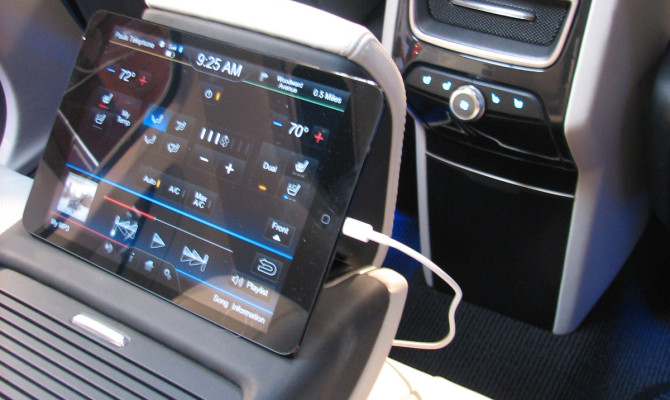
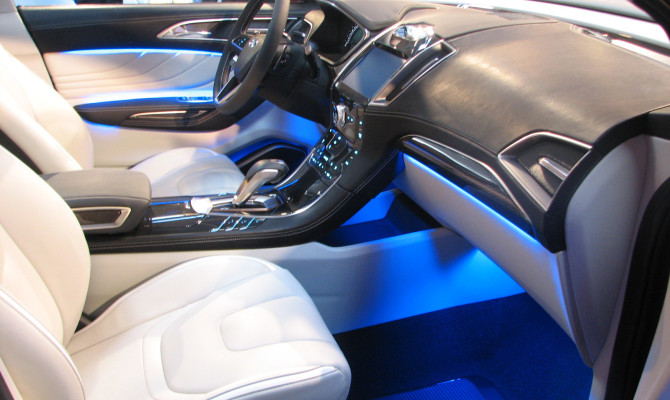
While most driving enthusiasts do not recognize the advent of a self-driving car as a good thing, drivers who have to endure crowded urban parking lots and the drudgery of stop-n-go highway commutes, on a daily basis, probably have a very different view.
The fully autonomous car may never become a reality for non-technical reasons. We are, however, seeing layer upon layer of new technologies that certainly move things along in that general direction and could make it technically feasible, and perhaps production feasible on a restricted basis.
The new Ford Edge Concept revealed at the Los Angeles Auto Show included two interesting automated driving technology advances that are currently under development by Ford… self-parking and obstacle avoidance systems.
What’s different about this advanced self-park technology is that it allows an owner to do it from outside the vehicle with a push-button remote. The vehicle can be automatically positioned in or be removed from a tight parking stall situation. That certainly beats crawling in or out of the rear hatch, when there’s not enough room to get in from a side door. This new system builds on Ford’s current active park assist feature, which is restricted to parallel parking situations and uses ultrasonic sensors.
Using similar sensor and automated vehicle control technology, Ford engineers are also working on an advanced obstacle avoidance system. The concept vehicle detects slow-moving or stationary obstacles in the same lane ahead and warn the driver. If the driver fails to steer or brake, the system automatically brake and steer the Edge around the object.
“Democratized technology” is an expression used frequently by Ford engineers. It’s about making leading-edge technologies, which traditionally took a long time to trickle-down from expensive luxury vehicles, available on popular, affordable vehicles much sooner, or even ahead of luxury class competition.
Ford’s current Active Park Assist system is already available on 12 models. This system automatically guides the vehicle into a parallel parking spot, while the driver controls the gas and brake pedals.
A “Lane-Keeping” system is available on 11 Ford models today. This uses a forward-facing camera to scan the road surface for lane markings. The system evaluates if the vehicle is drifting out of its lane and alerts the driver by vibrating the steering wheel. If the driver does not respond, the system provides steering torque to nudge the vehicle back toward the centre of the lane.
Adaptive cruise control and collision warning with brake support is available on 10 Ford models. The system uses radar to detect moving vehicles immediately ahead and modifies cruising speed if necessary.
Blind Spot Information System Available on 13 Ford models. Radar sensors in the rear corners monitor the spaces next to and just behind the vehicle. On the road, these sensors trigger a warning light in the mirror when there is another vehicle in the driver’s blind spot.
All of these sensor-based technologies make driving safer today and they could also be considered as building blocks for a more comprehensive automated driving system.
Email: bob [dot] mchugh [at] drivewaybc [dot] ca
**********
Things go greener with Coke… bottles
Ford and Coca-Cola have embarked upon an eco-marriage.
They’re both extensive users of plastic and both are committed to recycling and finding eco-alternatives. The first offspring of this somewhat unusual realtionship is the Ford Fusion Energi with a PlantBottle Technology interior.
PlantBottle Technology is the first-ever recyclable PET plastic bottle made partially from plants, instead of petroleum-derived materials. Already, more than 18 billion of these bottles have been distributed in 28 countries and Coca-Cola claims that this is equivalent to 400,000 barrels of oil saved. Using recycled PlantBottle bottles, Ford has produced the first-ever fiber that can be woven into durable, automotive-grade PET fabric.
Fusion Energi is the plug-in hybrid version of Ford’s global midsize car and it’s Ford’s most fuel-efficient sedan. Sound-absorbing recycled denim material, equivalent to more than two average-sized pairs of blue jeans, are also used in the car’s carpet liner and Ford already uses soy foam, made with soybeans, in every vehicle it builds in North America.
The Accord plug-in coaxed me into a little competition with myself every time out to achieve maximum fuel efficiency…
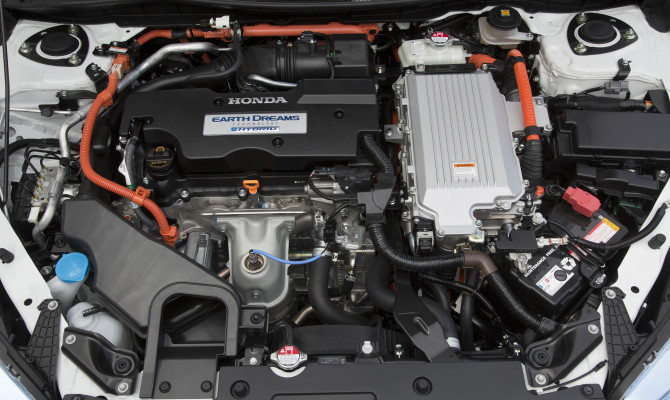
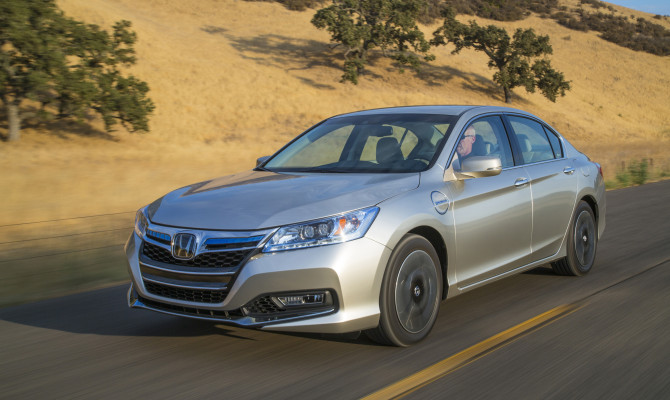
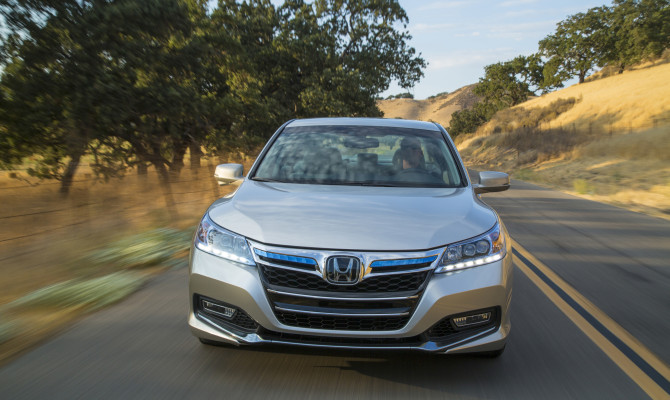
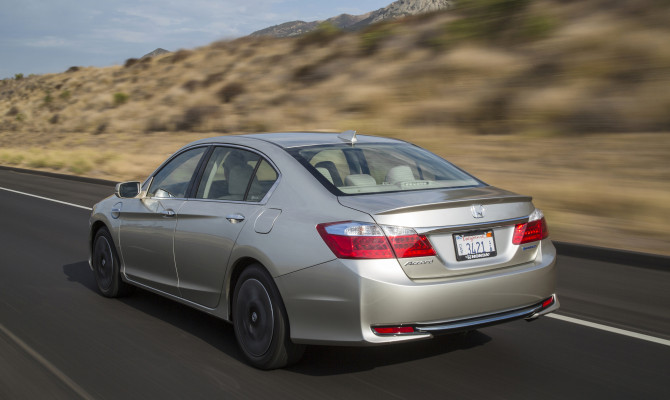
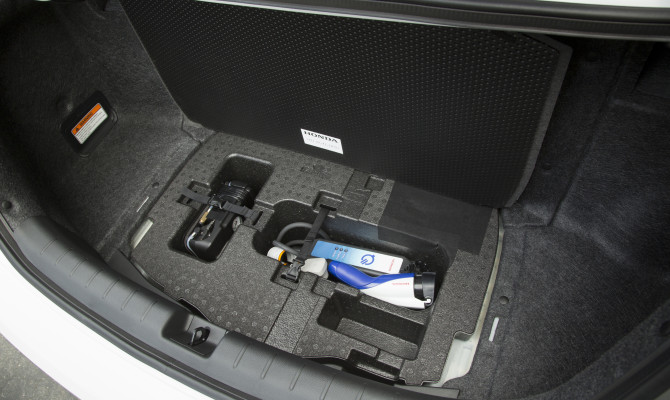
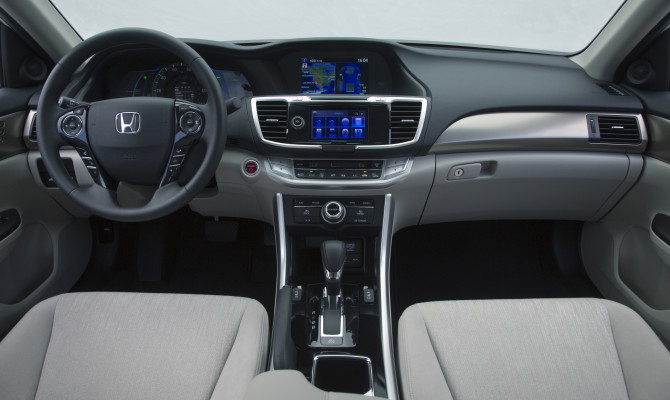
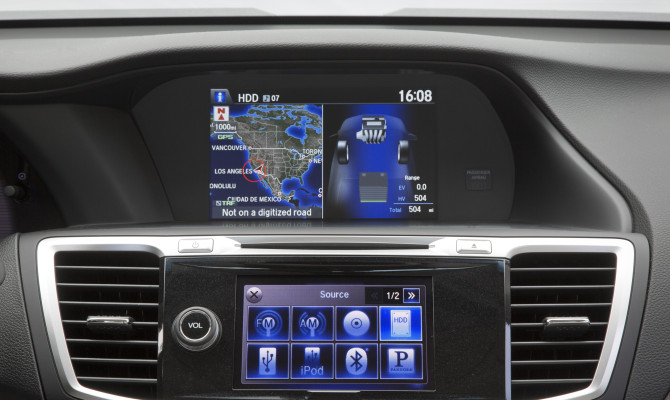
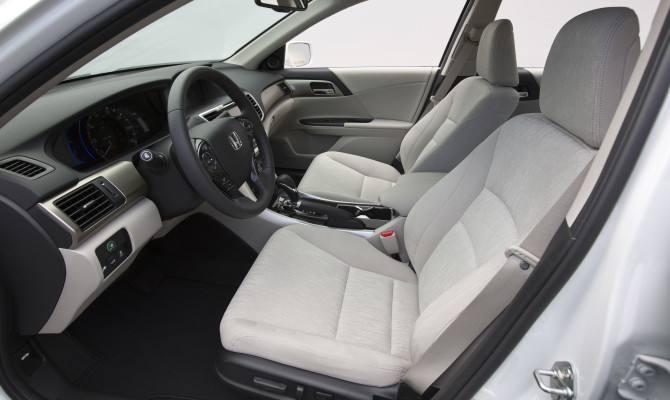
They should just call the 2014 Honda Accord Plug-in Hybrid Sedan The Gas Miser.
The car is here for market testing right now but surely, it will see production next year and arrive in dealerships later in the year. And when it does, sell your shares in Big Oil.
It only sips gas by the spoonful; how else do you account for an easily achievable 4.1 L/100km combined city/highway fuel economy rating?
Drive gently around town and you can purr along in all-electric mode for between 20 and 28 kms depending on road conditions. You won’t achieve that all at once, unless it’s the dead of night on a flat road, without any other traffic and green lights all the way.
However, it is estimated that if you achieve that 20-plus all-electric ride during a 100 km journey, the power unit will consume electricity/gasoline at an equivalency of around 1.6 L/100km. In truth, it’s hard to put a real life meaning into that number but it is useful when comparing with other similarly equipped cars.
But when you look at that number and the low gas/hybrid combined fuel performance, which enables you to journey 800 kilometres on one tank, it does plant the notion in one’s head that plug-in hybrids are the way to go for a while before we reach hydrogen fuel cell nirvana.
The car is powered by Honda’s first two-motor hybrid system, and uses a new, delightfully named, Earth Dreams 2.0 litre i-VTEC 4-cylinder engine producing 137 horsepower, teamed with a powerful 124-kilowatt (kW) electric motor. Electric driving is supported by a 6.7 kilowatt-hour (kWh) lithium-ion (Li-Ion) battery, and total system output is 196 horsepower.
If your eyes glazed over at the obligatory statement of power unit specifications, join the club! Fuel economy interests me more.
Like every other car with green aspirations that I have driven, it coaxed me into a little competition with myself every time out to achieve maximum fuel efficiency. It’s fun to select EV mode and pull away in the morning in silence, operating as a pure electric vehicle. Even in stop and go traffic, it works well, the regenerative braking keeps topping up the battery.
As the speedo creeps up the gas engine kicks in quietly and smoothly. If you select HV mode it operates as a conventional hybrid.
I drove a production version of the Ford Fusion Energi a few months ago, which is similarly equipped and impresses equally with its infrequent need to visit the pump. The plug in Toyota Prius is another contender for the green dollar. The Ford is probably the nearest equivalent and sells for around $35,000 so that will be the sticker price to beat.
I would like to hear from early adopters of the plug in hybrid technology about their experiences.
Contact:
Green Car Journal has identified its five finalists for the magazine’s high-profile 2014 Green Car of the Year program.
The five 2014 models include the Audi A6 TDI, BMW 328d, Honda Accord, Mazda3, and Toyota Corolla. These five finalists are also honoured as Green Car Journal’s “Top 5 Green Cars for 2014” and earn the magazine’s “Green Car Product of Excellence” honours.
An increasing number of vehicle models are considered for the program each year, a reflection of the auto industry’s expanding efforts in offering new vehicles with higher efficiency and improved environmental impact. Green Car Journal has been honouring the most important “green” vehicles every year at the LA Auto Show, since its inaugural award announced at the show in 2005.
“The diversity of this field of finalists illustrates not only that ‘green’ has gone mainstream, but also that there is no single approach to achieving ever higher levels of fuel efficiency and environmental performance,” says Ron Cogan, editor and publisher of Green Car Journal and CarsOfChange.com. “There’s something for everyone in this year’s field of finalists, including clean diesel, high efficiency gasoline, and hybrid/plug-in hybrid power featured in mainstream, sporty, and executive models.”
Finalists are selected for their achievements in raising the bar in environmental performance. Availability to the mass market is a factor to ensure honoured models have the potential to make a real difference in environmental impact, and finalists must be available for sale by January 1st of the award year.
Green Car of the Year jurors include auto enthusiast and Tonight Show host Jay Leno, plus leaders of the nation’s major environmental organizations.
The Driveway team will be at the LA Show to bring the winners of this program and all the highlights of the glitzy auto extravaganza in tinseltown.
Recent Comments
- { Enjoyed your Forest of Bowland in the BMW X5M, particularly the photo of the BMW in front of the main part of Stonyhurst College where... }
- { Bantam designed the Jeep, not Willy's or Ford. The American military gave the original Bantam prototype to Willys and Ford to copy. There is plenty... }
- { All Escalades come with a 6.2-lilter V8 engine that produces 420 horsepower. A six-speed automatic is the only transmission offered and drives the rear wheels.... }
- { Alexandra is an excellent journalist. }
Popular Posts
- Journey to a ‘Sparkling’ Luxury Okanagan Resort “Four lucky readers will put a Dodge Journey’s weekend-...
- The Need For Speed: Hike Those Highway Limits More than half of those polled believe the province sho...
- Drives-U-Crazy… Erratic drivers. An early morning drive from Kelowna to Vancouver is nor...
- Readers Respond: The Pros and Cons of Increasing B.C. Speed Limits Increasing the speed limits will only increase risk to...
- Honda CR-V Review: The Compact Crossover To Get Things Done The CRV is a very stylish and aerodynamic crossover veh...


